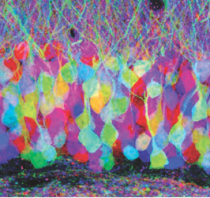Written by Sebila Kratovac
In the midst of scrambling to find an affordable, light-filled apartment in NYC last September, I was struck by my broker’s comment that he rarely gets requests for bright apartments from his male clients. His observation led me to think about the connection between sunlight and our sense of well being, and why women’s moods seem to be more affected by lack of sunlight. Research has shown that women account for three quarters of all seasonal affective disorder sufferers in the fall and winter months, experiencing lethargy, weight gain, and even depression.
to find an affordable, light-filled apartment in NYC last September, I was struck by my broker’s comment that he rarely gets requests for bright apartments from his male clients. His observation led me to think about the connection between sunlight and our sense of well being, and why women’s moods seem to be more affected by lack of sunlight. Research has shown that women account for three quarters of all seasonal affective disorder sufferers in the fall and winter months, experiencing lethargy, weight gain, and even depression.
The reason why sun exposure translates into good mood could lie in our bodies’ need for Vitamin D. The sun’s UV rays enable the skin to convert cholesterol into Vitamin D, which is then circulated via the blood stream and absorbed by  the kidneys, bones, intestines, and the brain. Sufficient absorption of Vitamin D is essential for good bone health, proper immune response, and optimal brain function. In the brain, Vitamin D enables calcium to regulate how neurons communicate with each other and how memories are formed. Vitamin D also plays a role in the production of neurotransmitters dopamine and norepinephrine, which work as stimulants to keep us more alert and motivated, to decrease appetite and anxiety, and consequently, to improve our mood.
the kidneys, bones, intestines, and the brain. Sufficient absorption of Vitamin D is essential for good bone health, proper immune response, and optimal brain function. In the brain, Vitamin D enables calcium to regulate how neurons communicate with each other and how memories are formed. Vitamin D also plays a role in the production of neurotransmitters dopamine and norepinephrine, which work as stimulants to keep us more alert and motivated, to decrease appetite and anxiety, and consequently, to improve our mood.
But why do women seem to require more sunlight to experience the same physical and emotional benefits as men? Women may have higher requirements for Vitamin D to keep their body healthy. The primary reason might, howe ver, lie in the way in which women’s brains integrate information from the environment and their emotional coping. This could be partly because women experience greater fluctuations in circulating reproductive hormones, possibly making them more susceptible to changes in the environment. Another explanation may be cultural: many jobs and recreational activities more closely associated with male social and economic patterns may take men out of doors more frequently, increasing their exposure to sunshine. Interestingly, animal models of stress have shown that females are more resistant to acute and chronic stress. As a result, males have perhaps evolutionarily adapted to more efficiently eliminate stress by avoiding it at any cost.
ver, lie in the way in which women’s brains integrate information from the environment and their emotional coping. This could be partly because women experience greater fluctuations in circulating reproductive hormones, possibly making them more susceptible to changes in the environment. Another explanation may be cultural: many jobs and recreational activities more closely associated with male social and economic patterns may take men out of doors more frequently, increasing their exposure to sunshine. Interestingly, animal models of stress have shown that females are more resistant to acute and chronic stress. As a result, males have perhaps evolutionarily adapted to more efficiently eliminate stress by avoiding it at any cost.
Although scientists have found substantial gender differences in gene composition within organs such as the kidneys, efforts to identify gender differences in the brain have been much more elusive. Scientists cite many roadblocks to studying gender differences. The brain is an anatomically and  cellularly heterogeneous organ and looking at intricate differences could be time consuming, expensive, and difficult to fund. Trying to extrapolate animal behavior data to humans could be very challenging and misleading. Some scientists are not willing to venture into gender research solely because they view it as “sexism;” Fortunately, some are willing to take the necessary risks. A study by Xu and colleagues, published in 2012 by the Cell magazine revealed that sex hormones regulate how behavior-specific genes are set up in the brain. The study suggests that female and male brains could be differently wired and could require a different mixture and level of nutrients for optimal mental health.
cellularly heterogeneous organ and looking at intricate differences could be time consuming, expensive, and difficult to fund. Trying to extrapolate animal behavior data to humans could be very challenging and misleading. Some scientists are not willing to venture into gender research solely because they view it as “sexism;” Fortunately, some are willing to take the necessary risks. A study by Xu and colleagues, published in 2012 by the Cell magazine revealed that sex hormones regulate how behavior-specific genes are set up in the brain. The study suggests that female and male brains could be differently wired and could require a different mixture and level of nutrients for optimal mental health.
Further studies examining cellular and molecular brain differences and how they correspond to behavioral changes in mood, could give us insight into how to better treat mood disorders for bo th sexes. Scientists such as Tracy Bale and Jill Becker, have started a dialogue and have conducted important research on gender differences in the brain. Clinicians could also greatly contribute to the advancement of basic science gender research by testing how mood-altering drugs affect women and men differently.
th sexes. Scientists such as Tracy Bale and Jill Becker, have started a dialogue and have conducted important research on gender differences in the brain. Clinicians could also greatly contribute to the advancement of basic science gender research by testing how mood-altering drugs affect women and men differently.
The effects of sunlight have given us important clues to the differences in how the genders relate to the environment; however, sunlight may only be a small piece of the gender puzzle. After two months of searching, I finally found that perfect, sun-filled apartment. I am now patiently awaiting new research to justify my stubborn perseverance.